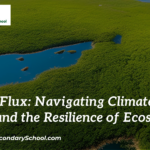Ecological Interactions
In the intricate dance of life on Earth, ecological interactions form the threads that weave together the rich tapestry of ecosystems. These interactions, ranging from simple to complex, define the relationships between organisms and shape the dynamics of our planet’s diverse ecosystems. From predator-prey relationships to mutualistic partnerships, understanding these interactions is key to unraveling the mysteries of the natural world.
The Circle of Life: Predator-Prey Interactions
One of the most iconic ecological interactions is the predator-prey relationship. Predators hunt and consume prey, exerting pressure on prey populations and shaping their abundance. This dynamic creates a delicate balance; as predators increase, prey populations decline, leading to a reduction in predator numbers, which then allows prey populations to rebound.
These interactions can lead to fascinating adaptations in both predators and prey. Predators evolve specialized hunting strategies, while prey species develop defensive mechanisms such as camouflage, mimicry, or toxins. This dance of survival and adaptation is a driving force behind the incredible diversity of life forms on Earth.
Competitive Struggles: Interspecific Competition
Interspecific competition occurs when different species vie for the same resources within an ecosystem. Whether it’s food, territory, or shelter, the struggle for limited resources can shape the distribution and abundance of species. When two species compete for the same resources, one might outcompete the other, leading to local extinction or niche differentiation, where species evolve to occupy slightly different ecological niches to reduce competition.
Competition can also have indirect effects. For instance, if one species is removed from a community, it might alleviate competition for resources, benefiting other species. These intricate interactions underscore the complexity of ecosystems and how they adapt to changes.
Mutually Beneficial Partnerships: Mutualism
In the natural world, cooperation is not limited to humans; mutualism is an example of symbiotic relationships where both species benefit. Mutualistic interactions can take many forms, from pollination—where bees and other insects transfer pollen between flowers, aiding in reproduction—to mutualistic relationships between plants and fungi, where plants provide sugars while fungi aid in nutrient absorption.
Mutualisms showcase the interdependence of species and how they have evolved to rely on each other for survival. These interactions highlight the fact that ecosystems are not simply collections of individual species but rather intricate networks of relationships.
Nature’s Recyclers: Decomposition and Detritivores
Decomposers and detritivores play a vital role in recycling nutrients within ecosystems. These organisms break down dead organic matter, such as fallen leaves and dead animals, into simpler compounds that can be used by other organisms. This recycling of nutrients is essential for maintaining ecosystem health and productivity.
While often overlooked, these interactions highlight the importance of even the smallest organisms in ecological systems. Without decomposition and nutrient cycling, ecosystems would struggle to support life.
The Ripple Effect: Trophic Cascades
Ecological interactions also have far-reaching effects that extend beyond individual species. Trophic cascades, for example, occur when changes in the abundance of one species lead to cascading effects throughout the entire ecosystem. For instance, if a top predator population decreases due to factors such as human activities or disease, the prey species it preys upon could experience population explosions, which in turn could impact lower trophic levels and even plant communities.
Trophic cascades exemplify the interconnectedness of ecosystems and underscore the importance of maintaining balanced relationships to ensure the health and stability of entire ecosystems.
Conclusion: Unveiling the Complexity of Life
Ecological interactions paint a vivid picture of the intricacies that define life on our planet. From the dramatic struggles of predator and prey to the subtle collaboration of mutualism, these interactions are the threads that connect species, ecosystems, and the planet as a whole. As we continue to explore and understand these interactions, we gain insights into the delicate balance that sustains life and the profound impact that human actions can have on the web of life. Preserving these interactions and fostering a harmonious relationship with nature is crucial for the well-being of both humanity and the countless species that share our world.





